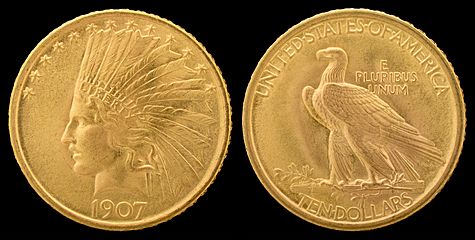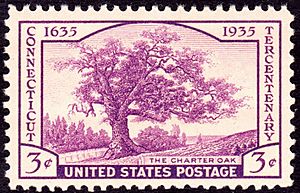Connecticut Tercentenary half dollar facts for kids
| United States | |
| Value | 50 cents (0.50 US dollars) |
|---|---|
| Mass | 12.5 g |
| Diameter | 30.61 mm |
| Thickness | 2.15 mm (0.08 in) |
| Edge | Reeded |
| Composition |
|
| Silver | 0.36169 troy oz |
| Years of minting | 1935 |
| Mintage | 25,018 including 18 pieces for the Assay Commission |
| Mint marks | None, all pieces struck at the Philadelphia Mint without mint mark |
| Obverse | |
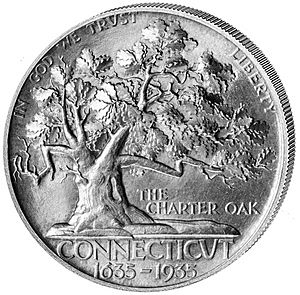 |
|
| Design | Charter Oak |
| Designer | Henry Kreis |
| Design date | 1935 |
| Reverse | |
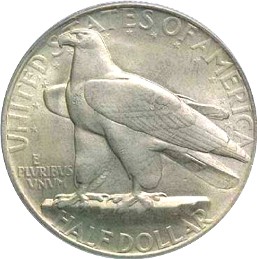 |
|
| Design | Eagle |
| Designer | Henry Kreis |
| Design date | 1935 |
The Connecticut Tercentenary half dollar is a special 50-cent coin made by the United States Mint in 1935. It was created to celebrate the 300th birthday of Connecticut. The coin was designed by an artist named Henry Kreis.
On one side of the coin, you'll see the famous Charter Oak. This tree is part of a legend where Connecticut's important charter (a special document) was hidden inside it. This was done to keep it safe from an English governor-general long ago. The other side of the coin shows a powerful eagle.
The Connecticut Tercentenary Commission wanted this coin made. They planned to use the money from selling the coins to help pay for their projects. A bill for the coin passed easily through Congress and became law on June 21, 1934. President Franklin D. Roosevelt signed it, allowing 25,000 of these half dollars to be made.
Even though the law said the government shouldn't pay for the design, Henry Kreis's artwork was part of a government project. His design was approved by art experts and the Treasury Department. The Philadelphia Mint first made 15,000 coins, which sold out very quickly. The commission then ordered the remaining 10,000, and those sold fast too. Today, these coins are worth much more than their original price, often selling for hundreds of dollars.
Contents
The Story of Connecticut and the Charter Oak
Connecticut was founded in 1635, even though people had been settling there for years before. In that year, John Winthrop the Younger became the first governor. At first, Connecticut didn't have its own official charter, which meant it could have become part of the Massachusetts Bay Colony.
The Charter and King Charles II
After King Charles II returned to the throne in England, Governor Winthrop traveled there. He managed to get a special charter for Connecticut, signed by the king on May 10, 1662. This document gave Connecticut important rights and freedoms.
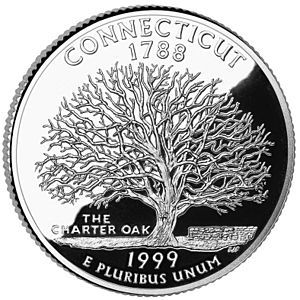
Hiding the Charter
Years later, in 1686, King James II tried to take away the charters of the New England colonies. He sent Sir Edmund Andros to be the governor-general. When Andros came to Hartford in 1687, he planned to take Connecticut's charter.
Legend says that during a meeting on October 31, 1687, the candles in the room suddenly went out. In the darkness, a man named Joseph Wadsworth quickly took the charter. He hid it in a secret hole inside the Charter Oak. This was a very old white oak tree on the Wyllys family's land.
The Charter Returns
After King James II was removed from power in 1688, the charter was brought out again. The famous Charter Oak tree finally fell during a big storm on August 21, 1856.
How Commemorative Coins Are Sold
In 1935, the government didn't sell special commemorative coins directly to the public. Instead, Congress would choose a specific group, like the Connecticut Tercentenary Commission. This group could buy the coins at their face value (50 cents) and then sell them to the public for a higher price. The extra money they made would help fund their projects.
Making the Coin Happen
The idea for the Connecticut Tercentenary half dollar started in the House of Representatives. Francis T. Maloney from Connecticut introduced the bill on March 26, 1934.
The Bill's Journey Through Congress
The bill went to a committee, which suggested some changes. They wanted to increase the number of coins from 10,000 to 25,000. They also added a rule that the government shouldn't have to pay for the coin's design. This meant the Connecticut Tercentenary Commission was supposed to pay the artist.
The House of Representatives discussed the bill on May 21, 1934. There wasn't much debate. After a few questions about whether the government would pay, the bill passed. It then went to the Senate, where it also passed without any problems on June 13. Finally, President Franklin D. Roosevelt signed it into law on June 21, 1934.
Designing the Coin
The design for the Connecticut Tercentenary half dollar was created by Henry Kreis. His work was generally overseen by Paul Manship, a well-known artist. Even though the law said the government shouldn't pay for the design, Kreis's work was part of a government project called the Public Works Administration.
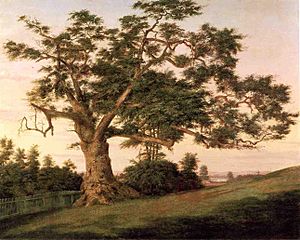
The Tercentenary Commission sent photos of Kreis's clay models to the Commission of Fine Arts. This commission gives advice on public artworks, including coins. One member, Lee Lawrie, had some suggestions for changes. For example, he thought the eagle's head and feet looked too much like a hawk's. He also felt the stars were too small.
Most of Lawrie's suggestions were used to improve the design. However, he didn't like a broken branch on the Charter Oak, but that part of the design stayed. The final designs were approved in early February 1935. The models were then sent to the Medallic Art Company to be made into coin-sized molds. These molds were then sent to the Philadelphia Mint to create the actual coins.
What the Coin Looks Like
The front (obverse) of the coin shows the famous Charter Oak. This image was inspired by a painting done by Charles DeWolf Brownell in 1855, a year before the tree was struck by lightning. Below the tree, you can read "CONNECTICUT 1635–1935". Around the tree are the words "IN GOD WE TRUST" and "LIBERTY".
The back (reverse) of the coin features a strong eagle standing on a rocky hill. The name of the country and the coin's value surround the eagle. To the left of the eagle's legs, you can see "E PLURIBUS UNUM" (a Latin phrase meaning "out of many, one"). There are also thirteen small stars, representing the original American colonies. These stars are very faint on some coins.
Expert Opinions on the Design
Coin experts have generally praised the design. Stuart Mosher, in his 1940 book, called it "among the most handsome of the entire series." He liked how simply the artist showed the large oak tree.
Art historian Cornelius Vermeule said that Kreis used the great oak "as a most effective composition." He also noted that the eagle on the back looked like it was "thrusting like a rocket." Vermeule felt that all parts of the coin's design worked together perfectly, similar to the famous Indian Head eagle coin from 1907.
How the Coins Were Made and Sold
The Philadelphia Mint first made 15,000 of the 25,000 authorized coins. These were struck by April 10, 1935. They were sent to the Hartford National Bank and Trust Company, which was in charge of selling them.
Quick Sales and More Coins
The coins went on sale on April 21, 1935, and sold out very quickly. On April 25, the commission ordered the remaining 10,000 coins. The commission asked if the coins could be made at different mints or in special "proof" condition (which are extra shiny coins). However, the Mint was too busy to do this.
Each coin was sold for $1. Besides the coins sold to the public, the Mint also made 18 extra coins. These were kept for testing at the annual Assay Commission meeting in 1936. To celebrate the anniversary, the United States Post Office Department also released a three-cent stamp on April 26, 1935, which also showed the Charter Oak.
Where the Coins Went
Six banks across Connecticut helped sell the coins through their branches. They put the coins in small boxes with the bank's name on them. People could also order coins by mail from the Hartford National Bank. Most of the coins were bought by people living in Connecticut. Only a few thousand were bought by coin collectors.
By July 1935, almost all the coins were sold out. The few remaining ones were saved for important people. According to coin expert Q. David Bowers, there were no problems with people trying to unfairly profit from this coin issue. Another expert, Anthony Swiatek, noted that the Connecticut Tercentenary Commission did a great job getting many of these coins to Connecticut residents.
Value Over Time
The Connecticut Tercentenary half dollar quickly became more valuable after it was released in 1935. Its price rose to $6 during a coin collecting boom in 1936. By 1940, the price went down to about $2.50. However, after that, its value steadily increased. During another coin boom in 1980, it reached $730.
Today, depending on its condition, the coin can be worth between $260 and $700, according to the 2015 edition of R. S. Yeoman's A Guide Book of United States Coins. The coin with the highest known quality was sold at an auction in 2002 for $9,487.


